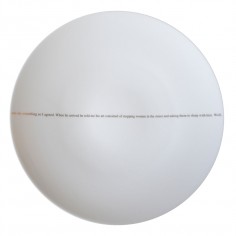Sophie Calle
The Pig / Le Porc Dinner Service

source: artwareeditions
This dinner service by Sophie Calle consists of six porcelain dinner plates fabricated by Bernardaud. Each plate tells a portion of a story told by Calle entitled, “The Pig.” When read in sequence the story is told in full and makes for a unique dinner party experience. The verso of each plate shows details of the service, the artist’s signature, and Bernardaud’s stamp.
This service is available in French or English. Dishwasher safe.
The story reads:
It is a silly story. I was about thirty. A man phoned to say that he and I were making similar work and should meet. I always worry I might miss out on something so I agreed. When he arrived he told me his art consisted of stopping women in the street and asking them to sleep with him. Well, he said, wasn’t one of my projects all about getting strangers to spend time in my bed? He told me he was taking me to a barbecue. I spent the whole evening playing the maid, grilling sausages, serving and cleaning up. Time goes by faster when you’re busy. Later he dropped me off outside my door. He leaned into me and saught my lips. I pushed him away. “What makes you think I’d want to kiss you?” I protested. “Well, anyway,” he answered, “you eat like a pig.” Even today, after all these years, his words haunt me. I can’t remember a thing about him, yet he’s still sitting at my table.
.
.
.
.
.
.
.
source: artspace
Sophie Calle is a French photographer, conceptual artist, and writer most famous for her performance-like projects where she plays detective and voyeur, involving herself in bizarre situations with strangers and recording them. For her 1980 project Suite Vénitienne, Calle followed a man she met at a party in Paris to Venice, where she disguised herself then continued to follow and photograph him. For her next project, The Hotel, she got a job as a chambermaid at a hotel in Venice and photographed the occupied guests’ rooms and all of their belongings. In The Shadow, she had herself followed by a private detective, who was unaware that she was his employer, and stealthily turned her own camera on him. All of these projects she presents later as photographs accompanied with text, meant to provoke a strong emotional, or shocked, reaction in the viewer.
Recent projects include her piece Take Care of Yourself, which was shown at the Venice Biennale and named after the last line of her ex’s breakup email. She asked over 100 women to interpret the email and posted the results in the French Pavilion. Though bizarre and often unnerving, Calle’s work continues to resonate with viewers because it is highly personal, brutally honest, and inventive. Her pieces are presented in major galleries and museums around the world.
.
.
.
.
.
.
.
source: arndtberlin
The French conceptual artist Sophie Calle is now considered as one of the most important artists of our time and was even recognized by Newsweek Magazine as one of the ten most important artists of contemporary art.
Since the late 1970’s she has been active as a photographer, combining text, image and conceptual installations. Her work amounts to a systematic laying bare of reality, whether it be her own or other people’s, with a limited portion left to chance. Absence of others is a central theme in her work. However Calle’s own existence plays an important role in her works. The documentary manner in which she presents her work suggests a high degree of factualness.
Calle grapples with modes of perception and identification by portraying life in all its diversity, handing over all the problems and questions to the viewer – and thereby, closing the loop, back to life itself – to find the answers. Her works are distinguished by the directness of her formal approach, her narrative skill, the conceptual enrichment they undergo over the course of their creation, and their power to draw in the observer with all his or her abilities and experiences. The uncertainty expressed in her works is what makes them so compelling.
“She uses photography in unique ways – no one else works with photography / text in this outstandingly original way – and she is a constant source of inspiration to younger generations of conceptually working artists.” Hasselblad Foundation, 2011.

